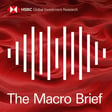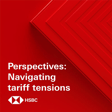Become a Creator today!Start creating today - Share your story with the world!
Start for free
00:00:00
00:00:01

DigiTalks: Implications of MiCA – the EU’s Markets in Crypto-Assets Regulation
In this podcast we discuss the implications of the EU’s Markets in Crypto-Assets Regulation (MiCA), which has been formally adopted by the European Council in May 2023. Listen as Mhairi Sandeman, HSBC Securities Services’ Senior Product Manager for Trustee & Fiduciary and Regulation, and Daniel Klingenbrunn, Principal Associate at Freshfields, discuss the final MiCA rules and consider the implications for crypto-asset service providers, issuers and the wider industry.
Hosted on Acast. See acast.com/privacy for more information.
Transcript
Welcome to DigiTalks
00:00:00
Speaker
Welcome to the latest in our DigiTalks podcast series.
00:00:17
Speaker
We are featuring a variety of different topics that are currently trending in the digital world.
Introduction to MICA with Vary Sandeman
00:00:23
Speaker
And we now explore the EU's Markets and Crypto Assets Regulation, or MICA.
00:00:29
Speaker
Introducing the topic is HSBC Security Services Senior Product Manager for Trustee and Fiduciary and Regulation, Vary Sandeman.
00:00:39
Speaker
Vary, over to you.
00:00:41
Speaker
Thank you, Gabriella.
00:00:43
Speaker
Now, in our Digitox podcast series, we've previously discussed MICA, the EU's Markets and Cryptoassets Regulation, in its draft form when it was introduced as part of the EU's Digital Finance Package.
00:00:57
Speaker
And MICA brings in a bespoke regulatory framework for cryptoassets and establishes harmonized rules across the EU.
00:01:05
Speaker
The final step in the legislative process has now been reached, with the European Council having formally adopted the new regulation, and it's expected it will take effect mid to late 2024.
Implications of MICA on Crypto Industry
00:01:19
Speaker
To help us digest the final MICA rules and consider the implications for crypto asset service providers, issuers and the wider industry, I am delighted to welcome Daniel Klingenbrun, Principal Associate at Freshfields.
00:01:35
Speaker
Daniel, thank you so much for joining me on the podcast today.
00:01:39
Speaker
Could you firstly explain please the backdrop and motivation for introducing the MICA regulation?
00:01:46
Speaker
Certainly, and thanks for inviting me.
00:01:49
Speaker
Mika was introduced for various reasons.
00:01:52
Speaker
In 2020, when Mika was initially proposed, the European Commission found that a new crypto asset financial market was developing without a uniform legal framework.
00:02:02
Speaker
Some member states had adopted specific rules governing crypto assets, while others had not.
00:02:07
Speaker
The Commission was concerned that investors, in particular retail investors, were not sufficiently protected and about the integrity of those markets, meaning the absence of fraud and market manipulation.
00:02:18
Speaker
On the other hand, Mika is a means to foster development of crypto asset markets and support innovation by a sound legal framework.
00:02:26
Speaker
To a certain extent, that is true.
00:02:29
Speaker
Bringing crypto assets within the regulated perimeter makes it easier for established players, such as banks, to engage in crypto related activities.
00:02:38
Speaker
Mika specifically addresses also the risks of one crypto asset, so-called stablecoins.
Stablecoins and Market Stability
00:02:44
Speaker
Stablecoins are basically a private issued currency with the aim to have a stable conversion rate compared to a legal tender.
00:02:52
Speaker
Mika was prepared at a time when several companies had announced the first global stablecoin, which caused considerable concern among regulators and central banks around the world.
00:03:04
Speaker
A stablecoin of significant size may impact the stability of financial markets and monetary sovereignty.
00:03:10
Speaker
Therefore, large parts of Mika impose rules on stablecoins.
00:03:15
Speaker
Thanks, Daniel.
00:03:16
Speaker
I'm interested to explore further the application of MICA.
Scope of MICA: Coverage and Exclusions
00:03:20
Speaker
You touched on stablecoins there.
00:03:23
Speaker
What sort of crypto assets will be captured?
00:03:26
Speaker
Which type of crypto asset service providers and issuers will be in scope?
00:03:30
Speaker
Also, will this be limited to EU firms?
00:03:34
Speaker
MICA is a gap-filling regulation.
00:03:37
Speaker
This means that it will only apply to crypto assets that are not already subject to other existing European regulation.
00:03:43
Speaker
For instance, if undertakings issue crypto assets that mirror debt instruments such as bonds or equity instruments such as shares, then these crypto assets would not be subject to MECA, but to the regime that already applies to traditional financial instruments, namely MIFID.
00:04:01
Speaker
In the legislative process was also controversial for a long time, whether non fungible tokens or so called NFT should be covered by Mika.
00:04:11
Speaker
Unlike normal tokens, NFT represent a unique right or value, such as a piece of art or a copyright.
00:04:18
Speaker
In the end, it was decided to not include NFT into Mika as they seem to be too far away from what is typically traded on financial markets.
00:04:28
Speaker
But this will always depend on the individual token.
00:04:31
Speaker
What happens if not one, but a collection of similar but not identical pieces of art are tokenized?
00:04:38
Speaker
Is each of them unique?
Requirements for Crypto Service Providers
00:04:40
Speaker
We will certainly discuss with regulators whether individual tokens are subject to Mika or be entirely unregulated.
00:04:46
Speaker
If a crypto asset is subject to me car, then it's issue and undertakings providing certain services for these cryptos are subject to regulation.
00:04:56
Speaker
An issue that issues a stable coin type of crypto asset is subject to a generally higher level of regulation for service providers, on the other hand, it makes no difference which type of crypto assets they provide the services for.
00:05:09
Speaker
And Mika covers the most important services such as custodian wallet providers or providers that exchange crypto assets against fiat currency.
00:05:19
Speaker
But it also covers services that would also be regulated when provided in relation to a share or bond, such as portfolio management or investment advice.
00:05:29
Speaker
Mika applies to the issuer or the service provider, regardless of whether it is established within or outside the EU.
00:05:38
Speaker
As long as a crypto asset is offered within the union or admitted to trading on a trading venue in the union, then MICA will apply to its issue.
00:05:47
Speaker
And as long as the service provider solicits its services to clients in the union, then the service provider is subject to MICA.
00:05:54
Speaker
Thanks, Daniel, for explaining that.
00:05:55
Speaker
And it's obviously a wide reaching application then.
00:05:58
Speaker
And could you please talk us through some of the high level requirements of MICA that will be brought in for crypto asset service providers or CASPs?
00:06:07
Speaker
So most importantly, Mika will require that the service provider obtains a license for providing its services.
00:06:14
Speaker
This means for third country firms that they will need a subsidiary within the European Union to provide the services.
00:06:20
Speaker
So on the other hand, the good message is the current fragmented legal framework for crypto assets will no longer exist.
00:06:27
Speaker
Once you have obtained a license in one member state, you can provide the services throughout the union, making use of your so-called European passport.
00:06:36
Speaker
There will also be a European AML regulation applying to those service providers.
00:06:42
Speaker
However, some regulated service providers may be released from an additional license requirement.
00:06:49
Speaker
Most importantly, credit institutions and investment firms are released from obtaining additional licenses.
00:06:56
Speaker
Investment firms, at least if they provide the same service in relation to traditional financial instruments.
00:07:02
Speaker
Regulated crypto asset service providers become subject to ongoing obligations, most of them are well known because they were copied and pasted from other financial markets regulation.
00:07:12
Speaker
This includes that members of the management have sufficiently good repute and possess appropriate knowledge.
00:07:18
Speaker
managing conflicts of interest and requirements on outsourcing.
00:07:23
Speaker
IT security is also understandably a central requirement.
00:07:27
Speaker
This should therefore not be overly complex to comply with for established credit institutions.
00:07:33
Speaker
Some observers nonetheless note that these safeguards would have prevented previous failures of crypto asset service providers such as FTX.
00:07:42
Speaker
So it is an important step forward for the crypto ecosystem to become more mature.
00:07:46
Speaker
As some business models are also unique to the crypto ecosystem, Mika establishes bespoke requirements for those services.
00:07:55
Speaker
For instance, the service as a custodial wallet provider will require these providers to operationally segregate own crypto assets from its client crypto assets.
Issuers' Obligations and Stablecoins Regulations
00:08:05
Speaker
this segregation must be carried out in a way that permits the client not to lose access to its crypto assets in case of the custodial wallet provider's insolvency the aim is to reach a similar level of legal certainty as for the custody of securities and client protection goes even further in case the custodial wallet provider loses the crypto assets for instance for reasons of it errors
00:08:30
Speaker
Clients may claim damages against a custodial wallet provider under statutory law.
00:08:36
Speaker
Thank you, Daniel.
00:08:37
Speaker
And what are the main impacts of MICA on issuers of crypto assets, including stable coins?
00:08:44
Speaker
So generally, any issuer that wants to offer its crypto assets in the union or seek admission to trading of a crypto asset within the union must publish so-called crypto asset white paper.
00:08:56
Speaker
When tokens are issued today, it is already common that this is accompanied with a document that describes the functions and economics of the token.
00:09:04
Speaker
However, these documents do not follow any rules and will often not be very helpful to give investors a clear overview of the risks.
00:09:12
Speaker
So the crypto asset white paper under Mika now sets out the content of these white papers in much detail.
00:09:19
Speaker
It very much resembles today's requirement to draw up and publish a prospectus for securities.
00:09:25
Speaker
There is also comparable prospectus liability.
00:09:28
Speaker
However, these crypto asset white papers are not approved by any authority.
00:09:33
Speaker
Things become a bit more complex if the issue or wants to issue a crypto asset that is a stable coin.
00:09:38
Speaker
In fact, Mika has two different regimes for different stable coins.
00:09:42
Speaker
If the stable coin purports to maintain a stable value by referencing the value of one official currency, for instance, a euro stable coin,
00:09:51
Speaker
then this falls in the regime for electronic money token.
00:09:54
Speaker
If another asset is referenced, for instance, the US dollar or the gold price or a basket of currencies, then the stablecoin falls within the category of asset reference tokens, which are regulated in a different manner.
00:10:06
Speaker
In short, the issuance of e-money tokens and asset reference tokens requires a license.
00:10:12
Speaker
This can either be a license as credit institution or an e-money institution in case of e-money tokens.
00:10:18
Speaker
Issues of asset reference tokens can alternatively apply for specific license under Mika.
00:10:24
Speaker
This also means that issuers of stablecoins must have a local presence in the EU to obtain such license.
00:10:30
Speaker
Bespoke ongoing requirements apply, such as how to handle the funds that are received in exchange for issuing a stable coin, the so-called reserve.
00:10:39
Speaker
This reserve must be custodied and invested in a certain risk minimizing way.
00:10:44
Speaker
If such stable coins reach a certain size, they can be determined significant by the European Banking Authority.
00:10:51
Speaker
And the European banking authority would then assume the role as additional supervisor over the issue.
00:10:57
Speaker
In order to address these specific risks of large stable coin arrangements, if these tokens reach a very significant size, meaning more than 1 million transactions and a transaction value of 200 million euros per day, it is prohibited to issue additional
Adapting to MICA: Impact on Firms
00:11:15
Speaker
tokens.
00:11:16
Speaker
So the growth of asset reference tokens is kept.
00:11:19
Speaker
Daniel, thanks for explaining so clearly there all the detailed requirements of MICA.
00:11:25
Speaker
Now, obviously, we need to wait for the rules to take effect, but what should firms be doing now to prepare for MICA?
00:11:32
Speaker
Firms should carefully consider what impact Mika will have on their business.
00:11:36
Speaker
Mika will not apply immediately, so firms will have time to adapt.
00:11:41
Speaker
Mika will become applicable 18 months after publication, which can be expected to.
00:11:47
Speaker
The rules on stablecoins will apply 12 months after Mika enters into force.
00:11:51
Speaker
In the meantime, the EBA will prepare all those technical rules that are required to apply MECA in practice and guide regulators and market participants.
00:12:00
Speaker
The impact on firms will vary.
00:12:02
Speaker
For established market participants, such as credit institutions, the impact will be less significant.
00:12:08
Speaker
they can largely rely on their existing set of licenses if they want to start offering crypto asset services or issues stablecoins they mainly need to adapt their internal processes and develop these new products and align them with mica some market participants have obtained licenses for crypto asset related services under current member states laws in particular Germany and France
00:12:33
Speaker
Unless member states decide differently, they will be granted a transitional period of additional 18 months.
00:12:40
Speaker
This could grant these firms a competitive advantage and we may see additional market participants applying for national licenses before MECA applies.
00:12:48
Speaker
Member states may also establish a simplified licensing procedure for these locally licensed entities.
00:12:55
Speaker
Firms from the US or other third countries without any local presence in Europe will be most affected.
00:13:02
Speaker
they will have to assess whether they establish a local presence and obtain the relevant licenses in Europe or stop soliciting their crypto assets or crypto asset services at all.
Global Influence and Future Directions
00:13:12
Speaker
We may therefore see a strong movement towards Europe.
00:13:15
Speaker
Thank you Daniel, some helpful pointers there.
00:13:19
Speaker
And obviously this is a significant regulation for the EU, but is Michael likely to have any bearing on jurisdictions and regulations outside of the EU?
00:13:30
Speaker
That is at least what the EU probably aims for so the European Commissioner McGuinness told the World Economic Forum that there is no point in Europe being on its own and that crypto is a global development that also requires a global approach.
00:13:43
Speaker
The Mika text itself emphasizes that the EU will support international efforts to promote conversions in the treatment of crypto asset and related services.
00:13:53
Speaker
through international organizations, such as the financial stability board, the Basel committee and the financial action task force.
00:14:01
Speaker
Given that Mika is one of the first truly comprehensive sets of rules in a major jurisdiction, it can be expected that it will have some impact.
00:14:09
Speaker
It will be in particular interesting to see what route the US will take.
00:14:13
Speaker
The recent collapse of FTX has certainly sparked the urgency for a comprehensive set of rules also in the US.
00:14:20
Speaker
There are already first statements from the SEC that MECA could serve as a model for US regulation.
00:14:26
Speaker
But much will also depend to which level US lawmakers will want to follow the model of legitimacy through regulation, that is the unspoken idea behind MECA.
00:14:37
Speaker
Daniel, thank you so much for joining me today to discuss MICA and for giving us a clearer view and summary of all the detailed requirements there and also the steps firms will need to take for readiness.
00:14:49
Speaker
As you say, it'd be really interesting to see MICA being implemented and the impact it might have on wider regulation globally.
00:14:56
Speaker
We hope clients have found these insights helpful, but if there's any further questions on this topic, please follow up with your HSBC representative.
00:15:05
Speaker
Gabriella, back over to you.
00:15:06
Speaker
Thank you.
00:15:08
Speaker
Thanks so much, Vary and Daniel.
00:15:10
Speaker
It's been really interesting to learn more about MICA for me as well.
00:15:13
Speaker
I would like to thank you for listening to this edition in our series of DigiTalks podcasts.
00:15:18
Speaker
We hope that you enjoyed learning more about MICA.
00:15:21
Speaker
Stay tuned for more from our podcast series as we explore more trends in the coming weeks.
00:15:27
Speaker
Thank you for joining us at HSBC Global Viewpoint.
00:15:30
Speaker
We hope you enjoyed the discussion.
00:15:32
Speaker
Make sure you're subscribed to stay up to date with new episodes.












